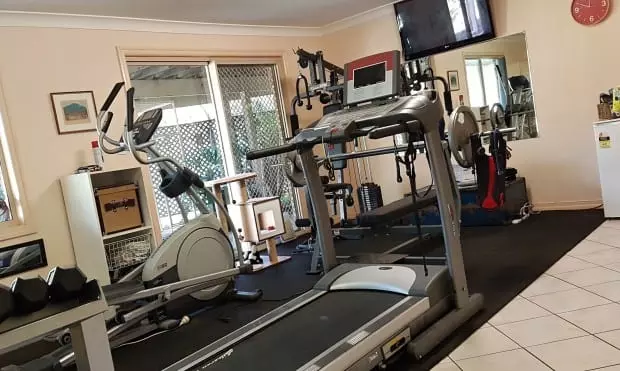I remember clearly how my wife and I mulled over the decision 10 years ago to buy a treadmill. We weighed up the pros and cons with the main one being, will we use it enough to warrant the purchase?
For many people considering buying a treadmill (or any other exercise machine for that matter), wondering if this expensive bit of equipment will get enough use to justify the purchase is probably the biggest question. In this post, I want to share my experience in buying and owning a treadmill exercise machine so that those reading this can make a better-informed decision on their own purchase.

Our home gym with treadmill (image above)
Impulse buy
I know most of us have fallen into the trap at some point in our lives and purchased things on the spur of the moment we later regret. We should always be careful not to impulse buy anything especially expensive items such as large exercise machines. The consideration for purchasing a treadmill should be born out of necessity rather than a sudden motivation to want to get fit, or something new to try.
When I state "necessity" I should be careful to point out that I mean the term loosely as there is seldom any situation when purchasing a treadmill is do or die; however, there are good reasons why someone could deem owning one necessary and some are:
- To use as an option – You already exercise regularly but at times you need an alternative aerobic method of working out. For example, your regular jog around the neighbourhood gets interrupted by bad weather and a treadmill would enable you to workout on those days when you otherwise wouldn't go for a run.
- To make allowances for obstacles to exercise – For some of us, it's difficult to find the time to go for a nice walk or run. Mothers, for instance, and something I can relate to as a home dad was trying to exercise whilst caring for a baby and toddler. Finding someone to care for the kids whilst I went for my jog was almost impossible but a treadmill allowed me to jog at home when the little ones were occupied playing or having a nap.
- To enhance your current training – You might already have a home gym set-up and purchasing a treadmill is a logical addition in order to improve the whole workout experience at home.
Now, I'm not saying you can't purchase a treadmill on the pretence that, I will get this machine and start exercising because it is possible buying an expensive exercise machine can be the motivation needed for a person to get fit and lose weight. But I just want to stress, that in my humble opinion buying a treadmill as the "motivation" to finally change a sedentary lifestyle to an active one is bad investment policy because there's a lack of historic evidence in your own lifestyle it will work and you could end up with an expensive eyesore that just sits there gathering dust.
You'd be better off trying exercising in other ways first for several weeks (or even months) such as walking, jogging, etc and then if you are still motivated and wishing you had the "option" to hit the treadmill at home – go buy one. Working out at the gym and testing how much you enjoy using a treadmill before going ahead and buying one is also beneficial for two reasons: 1 – see if you enjoy using it plus prove you are motivated to continue regular exercise, and 2 – get a feel for the type of treadmill machine you'd like to buy.
How to use a treadmill at home?
Using a treadmill at home seems pretty straightforward and for the most part, it is, however, there are a few points worth noting such as:
Maintenance – Treadmills do require a small amount of attention to keep them functioning well. Most treadmill users at their local gym wouldn't know that staff conduct regular maintenance on their treadmills so they tend to overlook this necessity when buying one for home. Treadmill machines have moving parts and although the main electric motor is enclosed there are things like treadmill mats/belts requiring lubricant and occasional adjustment (perhaps replacement) depending on the workload, also the machine needs regular cleaning to remove dust and grime build up that can cause unnecessary wear if left unattended. Some machines like this PRIME Treadmill by Lifespan on eBay AU (which happens to be several upgrades from the actual treadmill we purchased) now come with a self-lubrication system and this feature is very handy indeed.
Safety – Using motorised exercise equipment at home usually means it's unsupervised with the user likely on their own unlike a commercial gym where there are staff able to assist if something goes wrong, therefore, it's important that the machine at home has built in safety mechanisms like a large obvious stop button or an automatic stop/key if the user falls or needs to end the session abruptly. Treadmills are also potentially dangerous for children and are a temptation for little ones when parents have their back turned so a child safe start switch is advisable – ours has a magnetic button on the console that prevents the on-switch from working unless it is in place and this button can be hidden away from kids.
Positioning – Also overlapping with safety is the positioning of your treadmill to ensure you can see if anyone is approaching the machine when you are using it (particularly kids) but even for security and your own wellbeing because it can be quite startling when someone creeps up as you're working out in your own world listening to Oasis on your music headset. Likewise, try to give your treadmill enough space behind it (preferably several feet) in the case of a fall or misstep and away from other equipment to avoid unforeseen issues. If you are intending to watch TV whilst exercising then position the treadmill central to the screen as this will help prevent accidentally running off centre and tripping up.

Our treadmill is positioned central and clear from behind (image above)
General use – You should be aware that exercising on a treadmill is not the same as exercising without one. In other words, going for a jog on your treadmill is usually easier than jogging outside for a comparative distance and speed. Yes, I am aware there are other opinions on the internet contrary to mine stating treadmill exercising is close to or even practically harder than outdoor running but I politely disagree. This is not to say that treadmill exercise isn't challenging and good it's just that when you exercise indoors on a machine you exclude influences such as the wind, adjustments for surface variations, temperature fluctuations, and other external factors that may affect your workout.
Also, the surface is moving under the person on a treadmill so, in theory, I could jump up and down whilst still recording a distance although dangerous and stupid it does prove my point. Therefore, allowances should be made or at least these differences should be acknowledged otherwise you'd be simply cheating yourself. For example, training by running 10kms on a treadmill is good to do, however, if the end goal is competing in an organised outdoor 10km race it would be a good idea to train outdoors as well.
Furthermore, I tend to use slightly different constants when measuring my fitness gains on a treadmill compared to outdoor running. I would recommend using a treadmill according to time and use the distance travelled only as a guide to effort produced especially if the goal is to get fit and/or lose excess weight. For instance, select a workout time (perhaps 40 mins) and use the time as the "constant" that doesn't change. Then you can measure other factors like distance, intensity/incline, speed, and heart rate mapping against this time to monitor improvements in your fitness over an extended period. I think measuring performance on a treadmill with time as the constant is better than running a set distance because as your fitness improves your exercise times will reduce and you'll exercise less, unless you extend your sessions, in which case you're using time anyhow.
I often look back at my treadmill run history and use the time as a benchmark and try to better the distance made in that timeframe, whereas, on my outdoor runs I typically use the distance as a measure because I generally run from home on a circuit back to home. That is, I don't just run blindly around the neighbourhood until I reach a set time and then stop in the middle of nowhere… Rather, I measure a set distance from my home and back so I can use this as the constant and measure my ongoing performance levels. I know for a fact what that distance is so I can trust the figures but on a treadmill, it can be a little iffy.
I understand as I'm writing this "distance/time" thing is sounding a little convoluted but I wanted to explain in detail what I think is an important difference between treadmill exercising and an outdoor run/walk and how I account for it – anyway it's time to move on…
My final point regarding general use is an often overlooked practice for treadmills and that is warm ups and cool downs whereby people use the machine solely as a way to get the blood flowing and body warm before beginning their main workout and then use it again as a gentle way to wind down after a tough session. This is probably the most common use I have for our treadmill in our own home gym as it's a great way to prepare the body by going for a light jog before lifting weights. After the workout, a nice slow cool down jog or walk on the treadmill finishing off with some light stretching is a good way to end the session. No, I don't think this "limited use" (warming up cooling down) for a treadmill is a waste of money because it is an important part of a workout overall plus no doubt the machine will get supplementary use regardless.
Handy features to have on a treadmill exercise machine
The following list (not in any order) are my recommendations for features to get with your treadmill.
Safety key or stop button – I'm sure I don't need to spell out the fact that treadmills are not a toy and people can suffer terrible injury or even death if something goes wrong when using it. If you faint, slip, or misstep whilst jogging normally there's a potential for serious injury but do the same on a treadmill and the consequences can be even worse! In the past, people have fainted or fallen on treadmills and sustained awful trauma caused by the belt continuing to turn and that's why it's a good idea to buy a machine that has a safety key or at least some type of automatic emergency stop feature.

A safety key or magnetic key/button renders the treadmill inoperable when it's not attached to the console. This means without the key in place the treadmill cannot be started and if the key is pulled during a workout the machine will come to an abrupt emergency stop. This type of safety key is great to have as a prevention for unauthorised use such as children and can also be attached to the user via a pin or clamp on a length of cord so if the user does fall or can't reach the console the magnetic key is automatically pulled and the treadmill stopped.
Not all treadmills come with a safety key type feature because some people don't like the idea or feeling of the cord attaching them to the machine and I can totally understand that point of view. For advanced users and highly trained athletes, an emergency stop button that is easily accessed when the machine is in use is probably all that is required and if the machine is sited in a good position clear from any obstacles it's likely a fall will throw the person safely away from the belt anyway.
For beginners or people with health problems, I would recommend getting a treadmill with a safety key fitted and use it as per the operating instructions.
Weightbearing and sturdiness – When it comes to home gym running machines, there's nothing worse than trying to run on an unstable treadmill because it takes the focus away from exercising and makes you concentrate on staying safe instead meaning your workout will likely be less effective. A good treadmill should have limited body sway forwards, backwards, or sideways when in use, it should not be overly noisy, and it should be able to withstand heavy training without labouring or lagging.
When it comes to maximum user weight I would buy a treadmill with a maximum user weight capacity allowing for at least 10 – 20kgs (22 – 44lbs) above the person using it to compensate for the extra stress placed on the machine. Treadmills weighted from 130kgs (286lbs) + would be my minimum but preferably 150 – 200kgs (330 – 440lbs) + (even for a user under 100 kgs/220 lbs) is my recommendation for better stability and a closer match to actually running on the track.
Incline – I mentioned earlier how in my opinion treadmill running is easier (in general) than outdoor running, however, using the incline feature either manually or as part of a preprogrammed session is a good way to bring the simulation of running closer to the real thing. Rarely is an outdoor run completely flat even if it looks that way to the eye so simulating the rising incline on a treadmill is important for that reason plus running up hills is awesome for fitness training full stop.

Running surface adjustment or shock absorption – We all know running places a lot of pressure on a person's leg muscles and joints due to jolting or vibrations especially when jogging on hard surfaces. A good treadmill machine will have a graduated running adjustment function for the user to adjust the surface tension to their preference or at least a good overall shock absorption system to alleviate jarring and joint soreness.
Overall noise – Going hand-in-hand with the points above about shock absorption and also sturdiness is noise. An excessively noisy treadmill exercise machine can be very offputting to the user and other people during a workout and that's why a good solid machine designed by the manufacturer with noise reduction in mind is an important feature. If you have ever worked out on a dodgy machine that squeaks and rattles with every step or near someone who has you'd know how annoying a noisy treadmill can be…
Commercial motor and rollers – Another thing related to noise are the motor and rollers that move the belt. I admit I'm not the most mechanically minded person but I know enough to ensure any treadmill I buy should come with a high-quality electric motor that has a generous warranty (preferably lifetime). Not much should go wrong with a good quality fully enclosed electric motor it should be the last thing to breakdown and therefore come with a fair warranty so if it doesn't don't buy it.
Also, the rollers should be large and good quality with sealed bearings to reduce the friction on the mat/belt so it will last longer.
Belt length and width – For me personally, I wouldn't buy a treadmill that has a running belt width under 500mm (20inch). Even an inch, either way, in a treadmill belt makes a big difference because there's not much room for error as it is when using a treadmill machine and a skinny belt raises the chances of a nasty misstep considerably. A wide belt 500mm or more gives allowances for larger gate runners and for when people start to tire during a workout subsequently reducing their physical ability and concentration.
As far as belt length goes anything over 140cm (55inch) should be plenty long enough for most people.
Belt replacement depends on the original belt quality and of course how much use the treadmill gets. It's possible a good quality treadmill belt will mean you won't have to replace it for many years – we've haven't had to replace ours yet – but it's also possible it may need replacing after 3 or 5 years so buying from a solid retailer that stocks spare belts for their branded machines is a clever move.
Automatic lubrication – Something that will help preserve the belt is regular lubrication (as mentioned earlier under maintenance) and a treadmill with an automatic lubrication system would be my choice if I were buying another one today. Although an automatic system isn't a must by any means it certainly would be handy and one less thing to do in regards to maintaining home gym equipment.

Preset workout programs – I must admit to not using preset workout programs very often but it is handy to have this feature as an option to manually constructing your own. Realistically, I doubt there are many modern day treadmills that don't have preprogrammed workouts as standard.
LCD display and console with inbuilt speaker system – Again, most modern treadmills come with these features as they really don't cost too much to add from a manufacturing point of view so why not include it in the package. Initially, we used our inbuilt speakers for listening to motivational music although it's now redundant since we installed a TV in our home gym. However, a good LCD display showing a few graphics of your exercise progress and a range of statistics is obviously needed as it is something you are constantly referencing throughout your workout.
Whether or not you feel the need/want to pay for a more advanced LCD screen such as one that will play movies or connect to your smartphone, iPad, etc is up to you; although, I would be wary of chasing gimmickry at the expense of a mechanically reliable and practical treadmill. If you are an avid iPad or tablet user then consider a treadmill that comes with a built-in tablet or laptop holder (yes they do sell them) and then use your own portable media device comfortably seated on the machine without having to buy a stand or install a TV on the wall.
What is vital to have on a treadmill console are easy to see and operate controls. Control buttons such as speed up/down, incline up/down, stop/start, should be clearly marked and easy to operate especially during use when your eyes are bobbling around and hands unsteady due to movement. A nice to have is easy to reach secondary speed and incline controls on the treadmill arms or failing that big easy touch buttons in the centre of the main console.
Heart rate monitor (HRM) – Often treadmills come with a built-in HRM whereby the user places their hands onto the handles/arms of the machine and their heart rate is displayed on the console. At this point in time grab handle type HRMs are not very reliable and should be used as a guide only. However, some modern treadmills are now compatible with commercial HRM straps fitted on the chest (such as Polar wireless heart rate monitors) which communicate with the treadmill console and give the user a more accurate heart rate readout during their workout.

Naturally, if you already have an HRM strap and it connects to your smart watch or other portable electronic device then this feature built into the treadmill may not be necessary.
Folding capacity and portability – Depending on where your treadmill is positioned this may or may not be a big issue. Our treadmill is in a permanent position in our home gym so folding and moving it isn't something we often worry about, just the same, portability etc still is important even if you don't need to move it often because treadmills are heavy pieces of kit and without a good folding mechanism and method of moving it around it could be very problematic indeed.
For treadmills that fold up vertically ensure the base has some mechanical assistance, in particular, for lowering as the base on some commercial quality machines can be heavy so a lowering mechanism under control such as manual hydraulic lift/lower is advisable.
Our old commercial treadmill is massive and very heavy, nevertheless, it still is easy to fold up or move around due to its well-made portability features.
Where to buy a good treadmill?
We purchased our treadmill online at Lifespan's eBay shop here in Australia and like 99.9% of their customers we have been very happy with our machine and their service. You can see my review of the Lifespan treadmill we purchased 10 years ago here in our Reviews Section.
For USA readers check out eBay USA or there's also a large selection of treadmills on Amazon USA.
Likewise for those in the UK try here on eBay UK and also on Amazon UK.
You shouldn't be worried about buying a treadmill online as these days good online retailers are just as reliable as traditional stores. Do your research, check out the retailer's credentials, contact details, make sure they are based in your own country and are therefore covered under local consumer laws.
Initially, I did try to find a treadmill locally by searching sporting stores far and wide but I found the stock limited, features lacking, and prices bloated so I turned to the web and found online retailers were offering far better products for much cheaper prices. Many online sporting retailers are selling their own branded products with their own adapted features and improvements, which are better than the old famous brand items you tend to see in the "bricks and mortar" shops.
Conclusion
For those considering buying a treadmill, I hope this article has been informative and helpful. The aim of the article wasn't to convince you to buy a treadmill exercise machine, rather, I wanted to share my experience so that people can make a better-informed choice if they do decide to buy one.
Feel free to leave a comment below on your own thoughts and experiences with treadmills – I'd be interested to read them.













